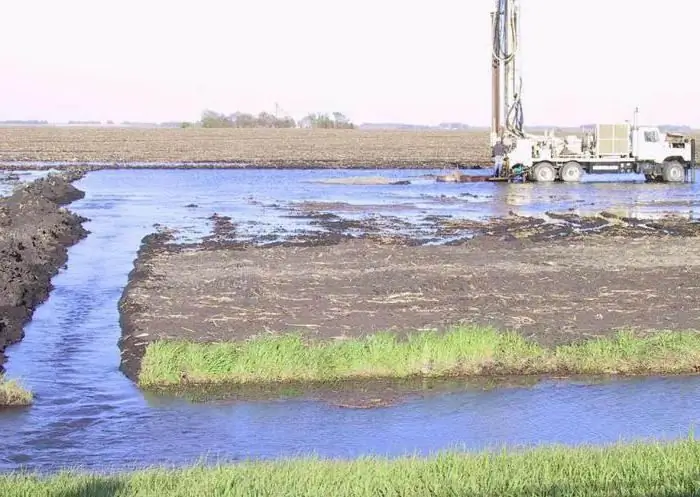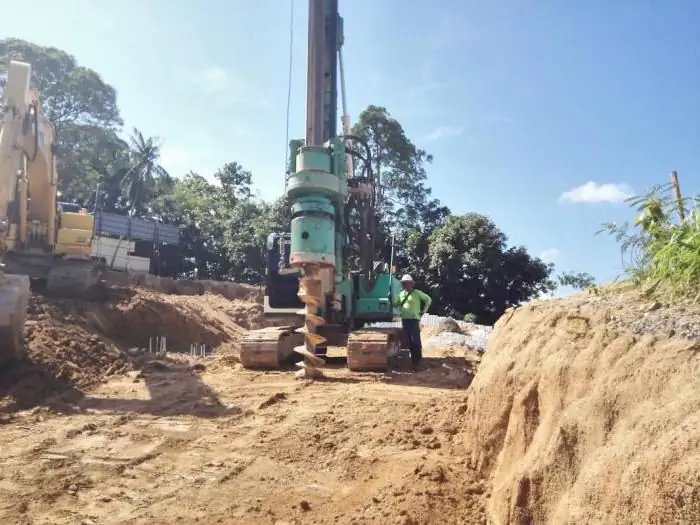2026 Author: Howard Calhoun | [email protected]. Last modified: 2025-01-24 13:10:41
There are many elements in the sewerage system that are designed to ensure the smooth operation of the network. The inspection well acts as one of the main structures, with the help of which specialists check the performance and clean the sewer. This indicates that these components of the system are the central link of the external sewage system.
Main varieties

Depending on the purpose, some types of manholes can be distinguished, among them: linear, rotary, nodal, control, flushing, differential, as well as special ones with enlarged neck sizes. Linear should be located on straight sections of the sewer system with a step that depends on the diameter of the pipe. Turntables are located where the system changes the direction of the lines, such as when turning. This type of well differs from the above tray configurations, which is represented by a smooth curve shape with a minimum radius of curvature. It should be equal to three pipe diameters. AtWhen determining the angle of rotation, specialists must remember that it should not be more than 90 °. The nodal inspection well is located at those points where several lines of the system are connected into a single whole. They have a tray assembly that connects a maximum of three inlet and outlet pipes. If we are talking about large collectors, then the nodal wells in them are called connecting chambers.
Description of other types of manholes

Control wells are located at the points of connection of the yard, intra-canal or factory network to the one located on the street. They are installed outside the construction line from the side of the houses. Such wells are necessary to control the operation of the system of added objects. Washing wells are installed in the starting sections, where there is a possibility of precipitation due to low speeds. Drop wells should be located at points where the inlet pipe and outlet pipe tray mark differ. Special wells have a more impressive neck and hatch. In this case, the collector must have a diameter of 600 mm, and the distance between the wells will be 50 m or more.
Features of the manhole

The inspection well is based on a tray, a hatch, a neck and a working chamber. The structure can be made of different materials: rubble stone, reinforced concrete blocks or bricks. In the diagram, these elements are indicated by polygonal, round or rectangular shapes. The base consists of a reinforced concrete slab laid on a crushed stone pillow. The main technological part is a tray made of monolithic concrete grade M200. In this case, formwork is used, which is poured with cement mortar and reinforced with reinforcement.
The inspection well has a pipeline that goes into the tray part, wastewater moves through it. If we are talking about a linear variety of the well, then its tray part is straight, and the lower part is vertical. The height of the tray must not be less than the parameter that determines the diameter of the larger pipe. On both sides of the tray there should be shelves that slope towards it. These shelves will serve as platforms where workers are placed during repair work.
Features of the main components of the well

If you are interested in the manhole device, then you should know that its working chamber has a height of 1800 mm. Whereas the diameter will be determined by the diameter of the pipe. If the last parameter is 600 mm, then the diameter of the working chamber should be 1000 mm. The neck has standard dimensions, which are equal to 700 mm. If the pipe diameter is 600 mm, then the neck must be located in such a way that cleaning devices can be placed in it. For descent, the working chamber and the neck are equipped with brackets and hinged ladders.
Government standards for manholes

A simple man in the street canit seems that the hatch is not such an important element of the manhole. But it's not. The main material for the manufacture of this component is cast iron. Cast iron hatches for manholes are manufactured in accordance with GOST 3634-61. This element includes a body with a cover for installation on the neck, and the diameter of the latter should be equal to 700 mm. The openings for the passage have a diameter of 620 mm. If there is a need to lay the hatch on the roadway, then its mass will be 134 kg, while the lungs are located on the sidewalks, and their weight is 80 kg.
Hatches of manholes, the GOST of which was mentioned above, can also be made of polymeric materials, the latter are lightweight, durable, environmentally safe and durable. When using polymeric materials, fillers are added to the ingredients during the manufacturing process, making the recycling process impossible. Therefore, such products are not of interest to recyclers.
Well device

In order for the system to function correctly, GOST must be used, manholes are made according to standards 8020-90. At the initial stage, earthworks are carried out, which provide for the need to dig a trench and a foundation pit. Before that, specialists carry out preparatory work in the form of marking the territory, demolishing shrubs and arranging a congress to the construction site. After the pit is ready, its bottom is cleaned, the angles of the slopes of the walls are checked against the project, as well as the levellaying. If you decide to use a stone structure, then at the bottom of the pit it is necessary to equip a waterproofing layer, the thickness of which should be 20 cm. Waterproofing can be done using bituminous mastic.
To create a concrete or reinforced concrete well, prepare the base, make a concrete pad, the thickness of the latter should be 10 cm. You can use a ready-made concrete slab.
Work methodology
Specialists carry out the installation of a tray of the desired shape from concrete with reinforcement in the form of reinforcement. Pipe ends should be sealed with concrete or bitumen. The inner surface of the rings is treated with bitumen. As soon as the bottom gains strength, you can proceed with the installation of rings and floor slabs. Then you should wipe the seams with cement mortar and waterproof them with the same bitumen. In places where the pipeline will enter the system, a 30 cm clay lock should be made, the height of which is 60 cm more than the diameter of the pipe.
Final works
Tests must be carried out within a day, for this the well is filled with water to the upper edge, and plugs are installed on the pipes. This recommendation only applies to sealed containers. Outside, the walls are covered with soil, which is well compacted. A concrete blind area is made around the neck, the width of which is 1.5 m. The remaining joints should be insulated with bitumen.
Conclusion
If you want the sewerage system to work properly, then you should use GOST. Cast iron hatches for inspection wells, for example,are also manufactured according to state standards, which were mentioned in the article above.
Recommended:
Well development: methods, process description, safety. Well repair

The article is devoted to the development of wells. The methods, features and nuances of the implementation of this event, as well as security measures and repair work are considered
Ejector - what is it? Description, device, types and features

Many people who have summer cottages could face such a problem as lack of water supply. In such cases, wells are usually dug, but it also happens that the water is too deep underground. In such cases, the ejector for the pump helps out perfectly
Leader well drilling for piles: technology, advantages and features

Leader drilling allows you to install piles in a vertical position in areas with dense soil. This method is most relevant in the winter, because it facilitates the process of driving a sheet pile when laying the foundation
Corn seeder: device, types, features and reviews

Corn seeders are widely used in the fields of agricultural firms. The technique of this variety may differ in design, sowing method, type of dispensers, etc. Such seeders are supplied to the market by both foreign and domestic manufacturers
What is a harrow: description, types, features and device

A harrow is an agricultural tool used in agriculture to cover moisture, comb out weeds and fight soil crust. Depending on the type of soil, its granulometric composition, the amount of moisture in the region, various types of harrows are used

